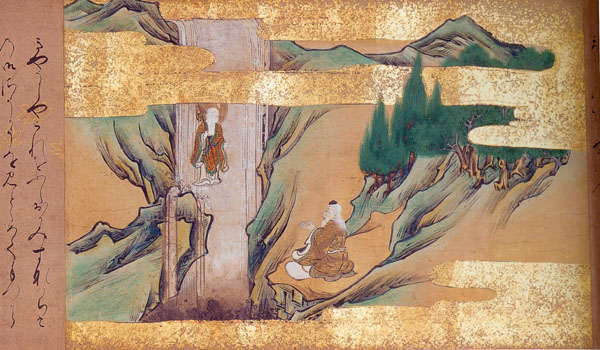Takishûgyo Suigyô Takigyô
Ascetic Meditation under the Waterfall
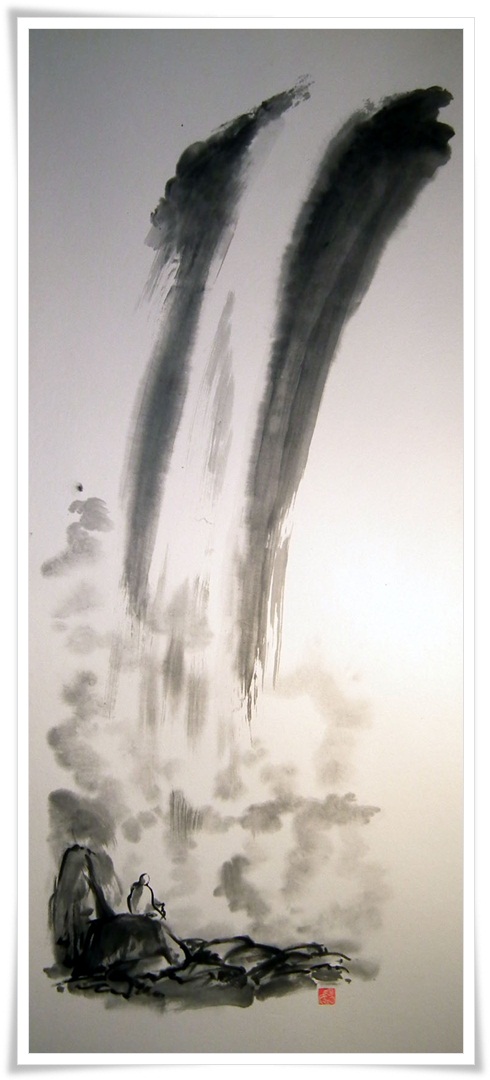
Mariusz Smedzt's painting, Poland, Yagyu Jubei Mitsuyoshi during his 100 days retreat period in front of Miei waterfall
Taki Shûgyô
Before speaking more specifically about the meditation on the element of water (one of the 5 elements of the Buddhist reliquary with the earth, fire, wind and ether/avoidness/vacuity) I would like to try to define what is asceticism and the ascetic path...
The Ascetic is a "Pilgrim of the Depths of the Consciousness"!
"To Trim" a tree is not to kill it but to increase the power of the sap so that the branch gives fruit: Such is the matter of the asceticism; to prune, "to cut" the man so that this one gives "fruits"! The ascetic digs a vacuum in oneself so that the Buddha can enter. The ascetic does not disavow the body and the spirit by mortifying the first to improve the second...but it opens them both, for the spirit in the body becomes a "temple"... The ascetics are mountaineers...Miners of the Conscisousness. The daily routine keeps us in our day to day practice, but it is the asceticism which makes us progress...
3 phases of the asceticism:
1) In the first level, one provokes passions. The practices are broken. One awakens the "animals" and the "demons" which live in us. One makes them howl so to know where they are and to prepare to track them... and by Introspection of the Consciousness, one goes down in the "cage to the deer" to overcome the Demons! It is what the mystics of all the traditions name: "the descent into Hell", like that of Dante, or going Orpheus his partner, or that of the Japanese god Izanagi to seek his wife who "died" in the kingdom of the ghosts & dead...hell is the place where you are face to face with the true nature of your ego. The danger at this stage, is the madness which is a danger for all those who begin the descent into the depths of the Consciousness.
2) In the second level, by the observance of the Buddhist Laws and Rules (Dharma), one will silence the "interior animals" in order to be able to cross the 6 lower states of consciousnesses and to be able to discover "the interior deserts" and to reach 7th of the 10 Higher state of consciousnesses. It is this 7th level that makes it possible to arrive at the 8th level: That of being All Happy, the "Pratekya Buddha" in Sanskrit and "Engaku Buddha" in Japanese.
3) In the third level, the ascetic discovers a place of Peace and perpetual rapture. It is the access to 8th, 9th then 10th levels of higher conscience: Worlds of Understanding of the Buddha-for-oneself, Boddhisattva and the Buddhas.
The first level, after having experienced the culpability, the revolt, repression, the disgrace... the ascetic reaches the second level by the observance of the rules of Dharma. The access to the 3rd level of conscience is made possible to the ascetic once he has transcended all his weaknesses and started "the power of the praise". It is by the praise that the "animal ones" are transmuted into Gods.! With the first and second level, the ascetic is self taught; on the 3rd level, it becomes "God taught": He who receives from the Buddha himself. At the bottom of ourselves a "Divine Presence lives", a gem of the nature of God or the Supreme Buddha, but it is necessary for us "to plunge" up to the 3rd level to be able to hope to touch this "diamond", this inalterable jewel.
How this "diving" into the depths of the interior of the conscious carried out?: The most intensive spiritual work is done in solitude… and in all major research into the core, the essence, the practitioner must freely select to complete it in solitude. In the caves of the mountains or the caves of the deserts, it is the solitude of gestation.
The risk in unselected (unprepared) solitude, it is that one can be unexpectedly touched by the Absolute and by the constraint and possibly be lead to madness...as people who were locked up in "dungeons", causing a forced solitude. In the "silence of the asceticism" (because the ascetic does not speak in retirement; mugon-No-gyo), loneliness becomes a mirror for oneself. Loneliness frightens the beginner-neophytes because they fear (rightly) of becoming insane there... But the Ascetic knows that to him, it is in loneliness that things are dissipated and that suddenly the "interior vision" sees... and that "the ear of the heart" listens.
At the beginning, after the noise of the heartbeat in the ears, there is only the "murmur" of silence, this last is crossed by "vociferations of the heart". It is the "noisy silence" which exists with 1st and 2nd levels of the asceticism. In this loneliness, we see ourselves... we are... we learn how to know ourselves... to recognize the self truly. Loneliness is a mirror for one place opposite the spirit and which reflects this spirit like the reflection of the moon in water! It is a powerful support for the ascetic to have such an object which constantly reflects the successive images of the "masks" which cover "the eye of the heart".
The Knowledge of True Self the is most difficult of the Paths to climb because this way is not traced in advance...each rise is a single track where he who walks on it is always the first to have climbed it (no one to lead you). One would like to see there the beauty of a vision of a Buddha or divine splendour with each corner they round...but before being able to remove the "masks", it is necessary to be able to look at these masks one by one to be able to demolish oneself some! This is often unbearable...
In solitude, the difficulty consists in understanding that essence is not to act but to be... to exist while becoming authentic! The solitary ascetic does not acquire anything... but gets rid of all superfluity. Silence speaks; it teaches... So sometimes loneliness seems fog, it is because the common consciousness has left.
There is a flame which seems to come from a river of fire in the eyes of the solitary ascetics, witnessed by those who come across them!
Yamabushi Kûban at the big waterfall O'taki on feet of volcano Asama in Japan 2007
The "interior desert" (samatha in Sanskrit) is reached when the man understands that all must be internalized: The hearing, the sight, taste... and all 6 directions and 6 means of perception. In this moment, one perceives a "special murmur", a "true thirst". It is the "grain of Sénévé" for the Western mystics and whom the Buddhists name in Japanese bodaishin, bodhicitta in Sanskrit, the aspiration of the awakening. It is the secret which solitude can teach, solitude is the path which carries us to this "Invaluable Jewel" which is the aspiration of the awakening and which makes it possible to feel the rapture of the Gods permanently! If in this solitude/loneliness, the drive behind our actions is altruism, then one becomes the Large Resplendent, a Buddha of Light. In the solitude of the ascetic practice, while contemplating it, one does not renounce the world of forms… one accepts them so that one can let it go. The practitioner becomes one with the forms so that he can, in time, die and become universal. Those who are caught in the "dance of words" of interior and external chattering cannot perceive the use of this "inner ear" which one calls: True Consciousness. They cannot hear the beauty and the immensity of silence... Since antiquity, in the caverns and caves, the ascetics who have lived the in the inner solitude perceive the "rustle" of this source in others. Although reclusive, the ascetic is not separated from others! Isolated at the bottom of its cave, he is in constant communion with all things similar! Distance and separation do not exist any more for him. In his strong interior, he feels all the vibrations of the Universe!
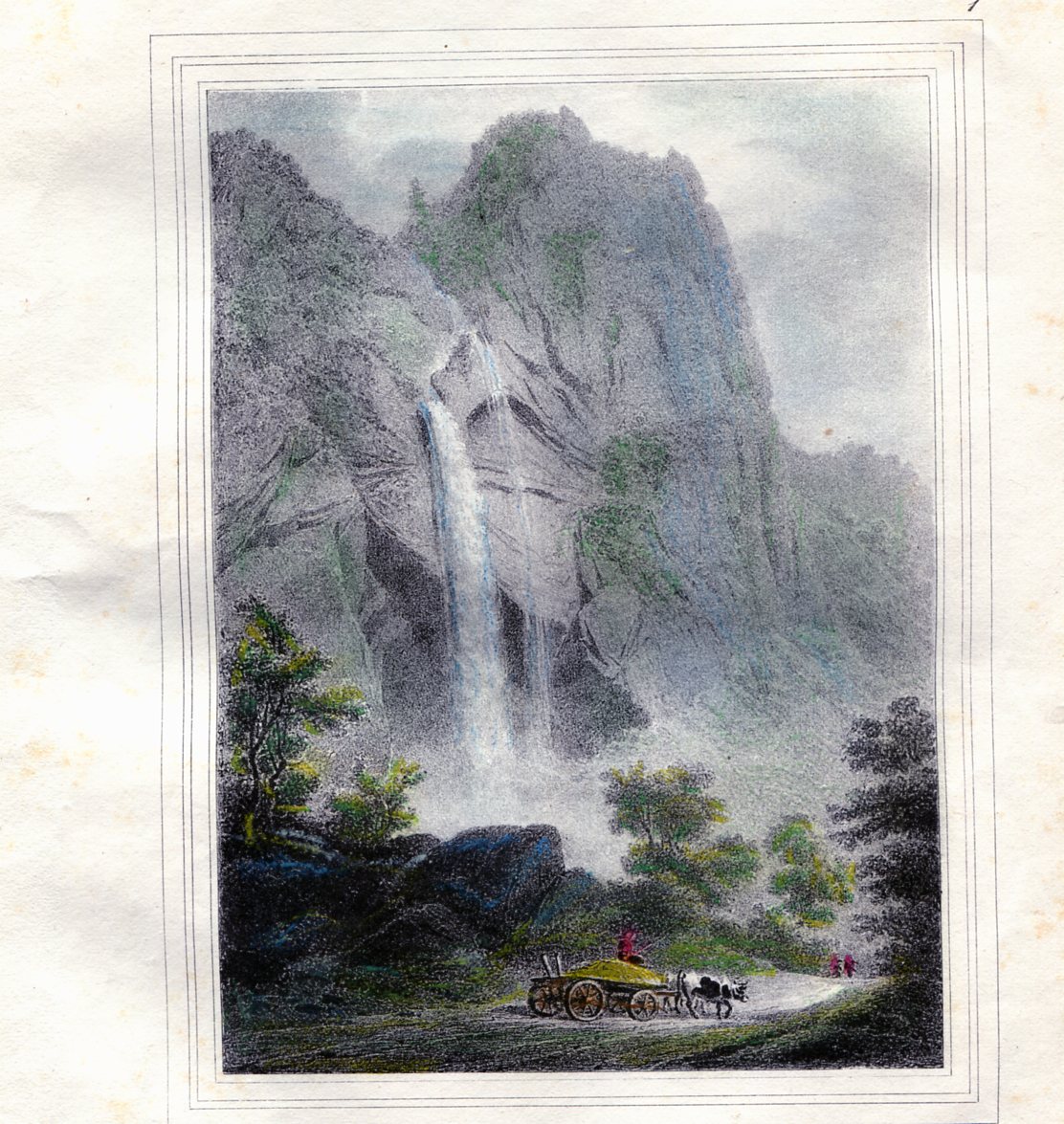
Chambery city France Alps, 1850 old carving paint by Courtoy, St Cassin waterfall /waterfall of Courmes,
Abbot Miyagi Tainen's Private Collection, Kyoto Japan
In Shugendo there are various types of asceticisms made as a recluse. These asceticisms are grouped together as they relate to the 6 elemental Buddhist tower (stupa): The earth (retreats in the caverns and caves, yamagomori or rokkugyo), water (with ablutions in the rivers, the sea, the lakes, suigyo, mizugyo, or under the waterfall "takishugyo"), fire ( "kassyo zanmai" and "Hiwatari"-walking on fire or ceremonies of fire-goma), the element of air with the ambulation while reciting mantras or particular invocations (kaihogyo), and the ether with the sitting meditation to obtain a Diamond Body (Tokkogatame meiso)
TAKISHUGYO or Asceticism linked to the element water
I would like to acknowledge the only work in French on the shamanic Japanese women of Shugendo, written by the ethnologist Anne Bouchy: "Oracles Shirataka" editor Presse Mirail Univ ISBN number 2-87730-127-3 & Nakai Shigéno written in 1992.
Since antiquity water has always been the purification element (with fire), an alchemic element whose symbolism is important in all traditions: Greek, Egyptian, Indian, Tibetan, Chinese or Japanese. In India, the Buddhist tradition retrieves that before accepting drinking the offered milk from Sujata, the Buddha Gotama “cleansed” himself in the river. Ritual ablutions in the Ganges River are renowned since the beginning of the Brahmanism. Even the Taoism grants a special importance to the practices under the water falls of the "Immortal" mountains to rid of the "dirt" of the world. It is therefore natural that the traditions of the native esoterics of China and India arrived in Japan. Shugendo, borrowing from shamanism, developed the practice of ritual ablutions in the rivers, the sea or under the waterfall, as in China.
In Japan, since the dawn of time, the shamans submersed himself in the sea, the rivers and in the torrents or under the water falls. There is therefore an animistic tradition (Shinto) of this practice (which is discussed in the work of Bouchy) even into 20th century. In Japan, the Buddhist tradition and asceticism of Shugendo has persevered all the more so! The practice carries the name of "Suigyo" if water is poured on the nude body (while sitting in a tub in winter)… "mizugyo" if ablutions take place in rivers or torrents... and of "Takishugyo" if this practice unfolds itself under a consecrated waterfall.
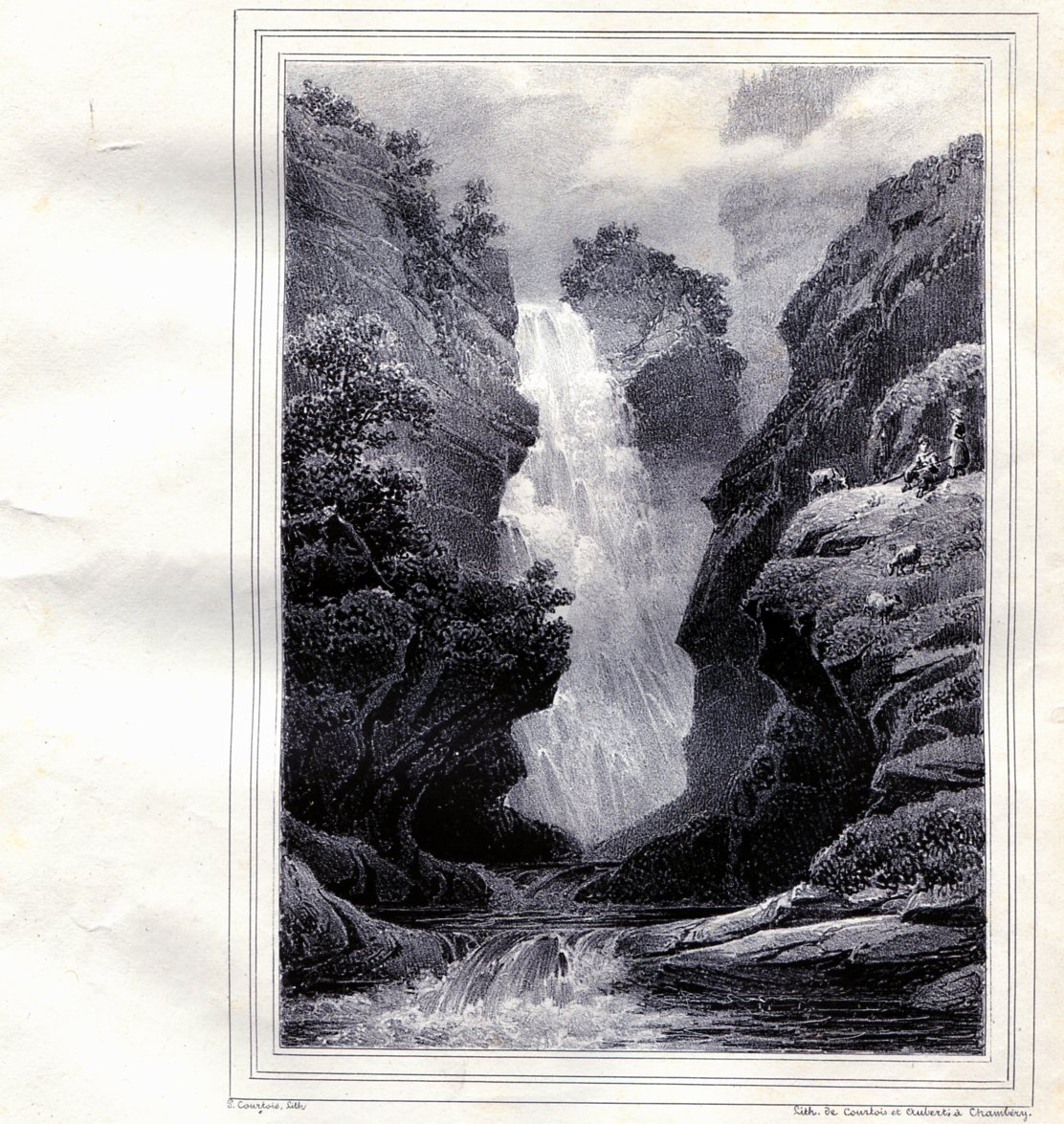
1850 Old picture carving by Courtoy; waterfall of Doria Chambery city in France Alps,
Seigen's private collection, Brazil Rio
More than a simple purification rite, the practice of "Taki Shugyo" is a particularly effective meditation on the development of the internal energy, as the practices of the Tumo with the Tibetans or the Qi gong of the Chinese. Nevertheless, in the "Taki Shugyo", there is a dissolution of the accumulated energies in the Sushuma path... this does not exist in Reiki or the Chinese Qikong. The practice of the asceticism under the waterfall can bring the accumulation of the necessary energies to heal. It is for that reason that the shamanic healers of Japan do their principal asceticism. As mentioned in the book by Bouchy, certain shamans, thanks to this practice, are able enter into relation (by way of possession) with certain very powerful spiritual forces. The ritual and the initiation to pass correctly under the cascades are very important. This rite must be transmitted by an empowered Master! For the ascetics of Shugendo, waterfalls are the body of the divine; energy of the Dragon that climbs towards the sky while the movement of water is descending. A sacred water that will awaken the "secret fire of the internal dragon", the fire of the Kundalini.
The practice of the asceticism under the waterfall can be curative for yourself or for the persons for which you practice. This is a means to develop courage and will during the begining of your progression on the Path... and it is very positive if one continues it throughout his life. But there are several major dangers, outside of the fact that rocks can fall on your head... The brain secretes a hormone that shrinks the size of the arteries when your head is exposed to extreme cold. If it is exuded in large quantities this hormone can cause diameter of the arteries to shrink violently and can result in a stroke or other brain damage! In addition the cold water of winter can provoke a drop in core temperature of the body that can be deadly(hypothermia or heart attack!) Therefore it should only be practiced with competent persons that transmitted to you the tradition! The potential to practice under the cascades for only several minutes and receive the "power" that results from this practice must not make us forget that this practice can be dangerous, especially in the winter! The practice has different rhythms according to desired results : practiced once only if it is a question of a purification rite before a pilgrimage. If the ascetic period is short but diffilcult, it can take place 3 times a days for 7 days or every morning on 100 or 1.000 days, depending on the goal... The practice can be shinto (animistic), buddhist (Shugendo) or purely esoteric. The beginer must always follow the counsels of the elders!
At Bunzô waterfall Katsuragi mounts Japan in november
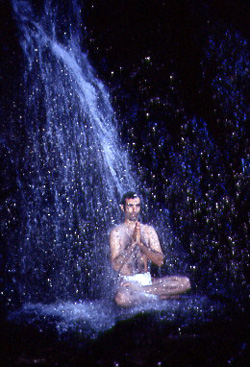
Kuban 1991 Sasaguri valley 88 Fudo temple pilgrimage
Fukuoka Kyushu Japan
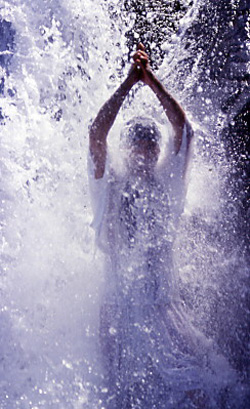
Kuban 1985, first Takigyo seminar in Pyrenean mountain at Viel Aure France
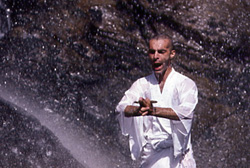
Kûban 1987, France, waterfall of Courmes near Nice City, South Alps of France
Cover page of Karate Magazine November
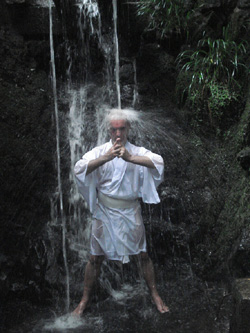
2007, Kûban performing shinto process takigyo at Inari shrine, Kyotaki,
Japan , Kyoto
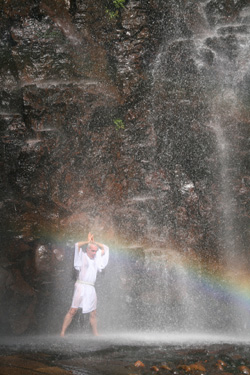
2007, Mts Ontake, Kyotaki, Japan
Venerable kûban performing Shinto process
Takigyo
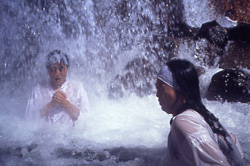
1991, Yamagata prefecture, Mts Yudono, Goshintai waterfall
Miko Sazaki sensei & student performing suigyo
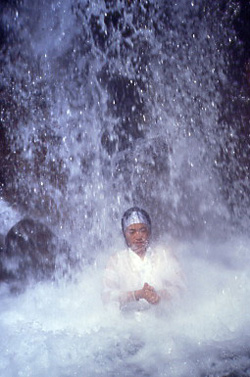
Miko Sazaki sensei performing Takigyo shinto process, Mounts Yudono waterfall
